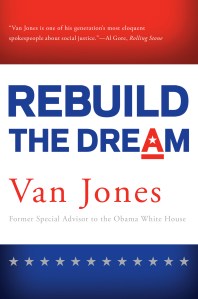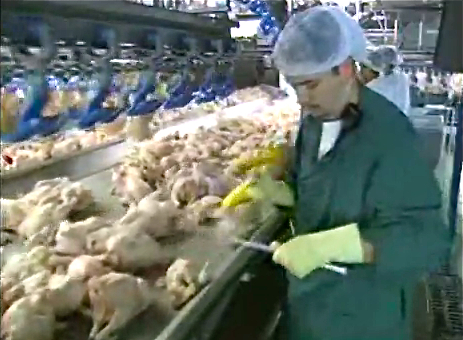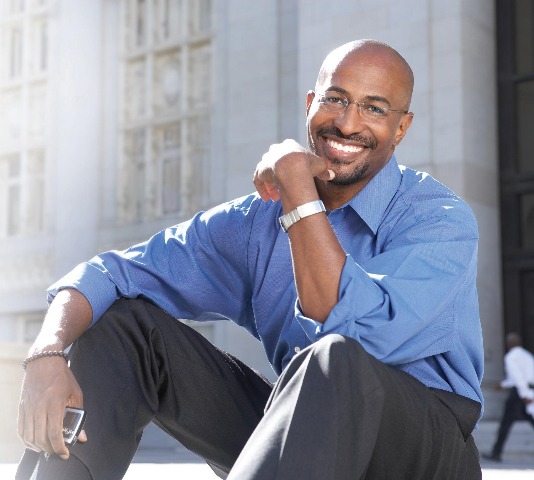
Van Jones. (Photo by Zach Gross.)
In his newest book, Rebuild the Dream, green economy pioneer Van Jones reflects on his journey from grassroots outsider to White House insider, shares intimate details of his time in government, and provides a blueprint for reinventing the American Dream. Along the way, he contrasts the structure and rhetoric of the 2008 Obama campaign, the Tea Party movement, and Occupy Wall Street. The following excerpt from the book focuses on a new green economy.
Many politicians want us to lower our expectations about the economy. I say it is time to raise them. We should go beyond the shriveled thinking imposed upon us by today’s mania for austerity. The time has come to propose solutions at the scale of the problems we face. We can and we must revive the economy — in a way that respects people and the planet.
For too long, we have acted as if we had to choose between strong economic performance and strong environmental performance. We have been torn between our children’s need for a robust economy today and our grandchildren’s need for a healthy planet tomorrow. We have been trapped in the “jobs versus the environment” dilemma.
The time has come to create “jobs FOR the environment.” We seem to forget that everything that is good for the environment is a job. Solar panels don’t put themselves up. Wind turbines don’t manufacture themselves. Houses don’t retrofit themselves and put in their own new boilers and furnaces and better-fitting windows and doors. Advanced biofuel crops don’t plant themselves. Community gardens don’t tend themselves. Farmers’ markets don’t run themselves. Every single thing that is good for the environment is actually a job, a contract, or an entrepreneurial opportunity.
We have our own “Saudi Arabia” of clean, renewable energy in America. In the Plains states, off our coasts, and in the Great Lakes area, we have abundant wind energy. With American-made wind turbines and wind farms, we could tap those wind resources and create jobs doing it. We also have abundant solar resources — not just in the Sunbelt and in our deserts, but on rooftops across America. With American-made solar panels and solar farms, we could tap the energy of the sun to create electricity. Then we could build a national smart grid — an internet for energy — to connect our clean-energy power centers to our population centers. That would create jobs and let us begin to run America increasingly on safe, homegrown energy.
 When we do this, we won’t be starting from scratch. According to the Brookings Institution, the United States already has 2.7 million green jobs. A bigger national commitment to building a green economy can create many millions more.
When we do this, we won’t be starting from scratch. According to the Brookings Institution, the United States already has 2.7 million green jobs. A bigger national commitment to building a green economy can create many millions more.
Every kind of American can and should adopt the clean energy agenda: liberals, conservatives, and libertarians; farmers, ranchers, and urban property owners; struggling youth and entrepreneurs.
Farmers and ranchers should love the clean energy economy because it would let America’s struggling, rural communities earn additional paychecks. For example, each wind turbine placed on a landowner’s property — which could still be farmed or otherwise used — could produce enough energy to bring in $10,000 to $20,000 per year. Green energy solutions are stereotyped as being “hippie power” for people in Berkeley, Calif., but it makes more sense to see renewable energy as cowboy power, rancher power, and farmer power.
Homeowners and commercial property owners should be thrilled about the clean energy agenda. The cleanest and cheapest watt of energy is the one that is never used. Hundreds of thousands of Americans could be employed in energy-efficiency jobs, retrofitting buildings to waste less energy and water. Such workers put in clean, nontoxic insulation; replace old boilers and furnaces; install better windows and doors, cutting home energy bills by 30 percent or more. If decision makers finance an energy-efficiency program the right way, the building owner would not pay an extra penny for all those services. The money would come out of the savings from her energy bill once a month; eventually the program would pay for itself through savings. Properly structured and financed, the same dollar bill would cut unemployment, energy bills, pollution, and asthma — in a program that paid for itself. These kinds of programs could be created through public-private partnerships and could put people to work right now. Bill Clinton says in his book Back to Work that a million people could be employed in the energy-efficiency field. The initial financing could come from the banks that are sitting right now on a couple trillion dollars of uncommitted assets. Those bankers got government bailouts to keep them in their jobs; it’s time for them to help create some jobs for the rest of America.
Young people and the parents of unemployed youth should be thrilled about green and clean energy jobs, especially in struggling communities. Idle youth could be trained to put up solar panels, retrofit homes, tend community gardens, plant trees, and strengthen communities. Some say we cannot afford to train youth and place them in green industries. But if members of this abandoned generation start engaging in desperate and foolish acts, society will pay a potentially heavier price. Regardless, we are already paying a tremendous opportunity cost by letting youth unemployment rates climb to 45 percent or more; for African American teens in urban areas, the numbers are staggering. We don’t know how many Bill Gates, Steve Jobs, and Oprah Winfreys are being left out of the economy. Perhaps we should reallocate oil-industry subsidies toward these employment programs. Our most precious resource is not our petroleum; it is our people.
As we think about a new economy, perhaps we can begin to apply some new math — and begin to count what really counts. The earth counts; our kids count; the future counts. Where economic and energy policy meet, we should calculate not only what we spend, but also what we save. And we should consider the payoffs from the investments we make in human and natural capital.
Excerpted with permission from Rebuild the Dream by Van Jones, published by Nation Books, a member of The Perseus Books Group. Copyright © 2012.



